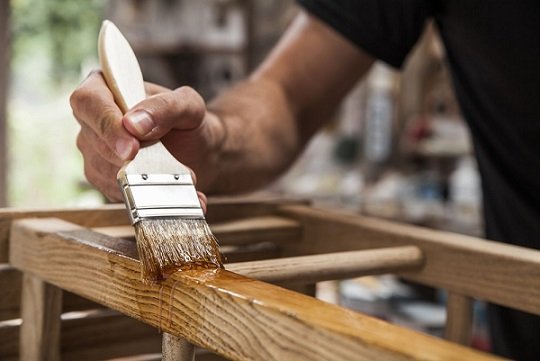Finishing wood transforms its appearance while protecting it from environmental and physical damage. It involves the application of some liquid to a wooden surface that dries into a protective coating.
Penetrating finishes like tung and linseed oil give the wood a natural appearance, while varnish and polyurethane are highly resistant to heat and water.
Choosing a Stain
Almost all wood furniture requires some form of stain. While some prefer unfinished wood’s raw, natural look, most would rather have a more vibrant aesthetic and added protection from moisture damage. Staining is the process of cleaning, sanding, and adding color to wooden surfaces before applying a protective clear finish.
To ensure the best results, wood finishing contractors will thoroughly clean the furniture and allow it to dry completely before staining. Sanding the surface before staining helps create a smooth, even texture and will help open up the pores so the stain can penetrate more effectively. After sanding, repairing any scratches or chips with putty or wood filler is important. This will prevent these imperfections from showing through after the stain has dried.
Stain colors range from light and natural tones to darker, richer hues. Choosing a color that complements the existing decor and desired style will help achieve the most appealing results. It’s also worth considering the opacity you prefer; some stains are more translucent, allowing the wood grain to show through, while others are more opaque and provide a more uniform appearance.
There are many different types of wood-finishing products to choose from. The type you choose will depend on various factors, such as its durability, whether it provides a specific color or no color, how quickly it dries, and how much it emits in terms of volatile organic compounds and formaldehyde.
Choosing a Finishing Method
Finishing is the process of adding a layer of protection to wood. It is typically one of the last steps in any woodworking project, but it is very important. Finishing protects wood from damage by sealing the pores and protecting against water and chemicals. The finish also helps enhance the look of the wood. Many different types of finishes are available for wood, including stains, paints, and varnishes. Each has its own set of advantages and disadvantages.
Choosing a finishing product will depend on several factors, including color, ease of use, durability and price. For example, if you use a stain containing pigments, you will want to choose a finish that can handle the stains and has good dilution properties for maximum efficiency. If you choose a clear coat like varnish, you must ensure it dries quickly and does not emit toxic fumes.
It is necessary to sand the surface before applying any finish to the wood. This can be done by hand with a sanding block or power sander. The sanding process is intended to remove cutter marks, scratches and other imperfections that will mar the appearance of any finish that may be applied later. In addition, sanding will help prepare the surface for any additional work that may be required, such as filling or patching holes and cracks with wood putty.
Choosing a Finishing Product
Choosing the right product is one of the most important aspects of wood finishing. Woodworkers usually want to select a finish that is durable, easy to use, provides either color or no color, dries quickly and emits fewer toxic fumes. They also want to choose a finish that is not toxic and lead-free since VOCs and information can harm people and the environment.
Some finishes, such as boiled linseed or 100% tung oil, are less toxic than others. Others are more toxic, such as lacquer. Some woodworkers like to use mineral oil, which can be bought at any drugstore and applied with a rag. It doesn’t add any hardness or change the colors of the wood, and it can be reapplied at any time.
Stains provide a wide variety of colors and accentuate the grain patterns. They can be durable, although they don’t protect the wood as well as a top coat would. They are typically composed of pigment, a carrier that inserts the pigment into the surface, and a binder to make it all stick together.
Shellacs are natural wax finishes that come in many colors and quickly dry. They are often used as a first coat or to protect a stain. A top coat of polyurethane is extremely protective and resists heat, water, and chemicals. It has several gloss options, including satin, semi, and high gloss.
Choosing a Wood Finishing Contractor
Wood finishing is an art form that requires years of experience to master. It changes how the wood looks, feels and smells. It also protects the work from environmental and physical damage and adds to its durability. A quality finish adds depth to the appearance and is smooth, lustrous, and pleasant.
Before applying any finish, the surface should be thoroughly cleaned and brightened. This will prepare the wood for coating and help to ensure a quality finish. A sanding dust mask should be worn during this step. During this time, the sanding process will expose new wood; if an old coat of stain is present, it must be stripped with a chemical stripping product.
The color and appearance of the finished product will depend on the type of stain, paint or varnish used. For example, a darker stain will be amber, while a lighter tint will appear milky in certain areas due to microfoam – tiny bubbles trapped within the finish.
A penetrating oil or water-based varnish is an excellent choice for furniture because it reduces the amount of moisture absorbed into the wood and can slow seasonal expansion and contraction. This will prevent stresses that can damage joinery and cause doors to rattle in winter or drawers to stick in summer.
